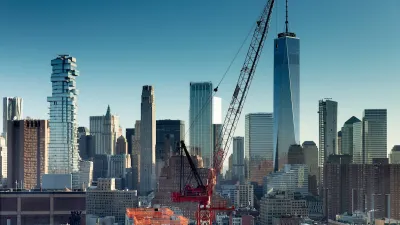A new study makes a visual case against the narrative that spot zoning and a broken development approval process are running roughshod over the entire city.

Steven Sharp shares news of a new study [pdf] released by the UCLA Anderson Forecast and the UCLA Ziman Center for Real Estate that puts the planning and development approvals process in context by aggregating all of Los Angeles' zoning changes for specific parcels, which the study describes as "spot zoning."
The study comes at a time of controversy over the planning process and the impacts of development in the city. The findings of the report, however, probably run counter to the narrative of runaway development preferred by advocates for the Neighborhood Integrity Initiative.
Authored by C.J. Gabbe, the study identifies properties with zoning changes of two kinds: those that allowed for more residential density and those that allowed for less density. Here Gabbe summarizes the findings:
Zoning designations were largely static: On average, the City upzoned 225 acres and downzoned 216 acres annually between 2002 and 2014. (Los Angeles' total land area is about 300,000 acres.) That is less than two-tenths of one percent of its land area every year.
Another provocative layer of conclusion drawn from the report's findings: in Los Angeles, "the most desirable neighborhoods with access to valuable amenities are also the most difficult to upzone."
FULL STORY: When and Where Does Upzoning Actually Happen?

Planetizen Federal Action Tracker
A weekly monitor of how Trump’s orders and actions are impacting planners and planning in America.

Congressman Proposes Bill to Rename DC Metro “Trump Train”
The Make Autorail Great Again Act would withhold federal funding to the system until the Washington Metropolitan Area Transit Authority (WMATA), rebrands as the Washington Metropolitan Authority for Greater Access (WMAGA).

The Simple Legislative Tool Transforming Vacant Downtowns
In California, Michigan and Georgia, an easy win is bringing dollars — and delight — back to city centers.

The States Losing Rural Delivery Rooms at an Alarming Pace
In some states, as few as 9% of rural hospitals still deliver babies. As a result, rising pre-term births, no adequate pre-term care and "harrowing" close calls are a growing reality.

The Small South Asian Republic Going all in on EVs
Thanks to one simple policy change less than five years ago, 65% of new cars in this Himalayan country are now electric.

DC Backpedals on Bike Lane Protection, Swaps Barriers for Paint
Citing aesthetic concerns, the city is removing the concrete barriers and flexposts that once separated Arizona Avenue cyclists from motor vehicles.
Urban Design for Planners 1: Software Tools
This six-course series explores essential urban design concepts using open source software and equips planners with the tools they need to participate fully in the urban design process.
Planning for Universal Design
Learn the tools for implementing Universal Design in planning regulations.
Smith Gee Studio
City of Charlotte
City of Camden Redevelopment Agency
City of Astoria
Transportation Research & Education Center (TREC) at Portland State University
US High Speed Rail Association
City of Camden Redevelopment Agency
Municipality of Princeton (NJ)





























